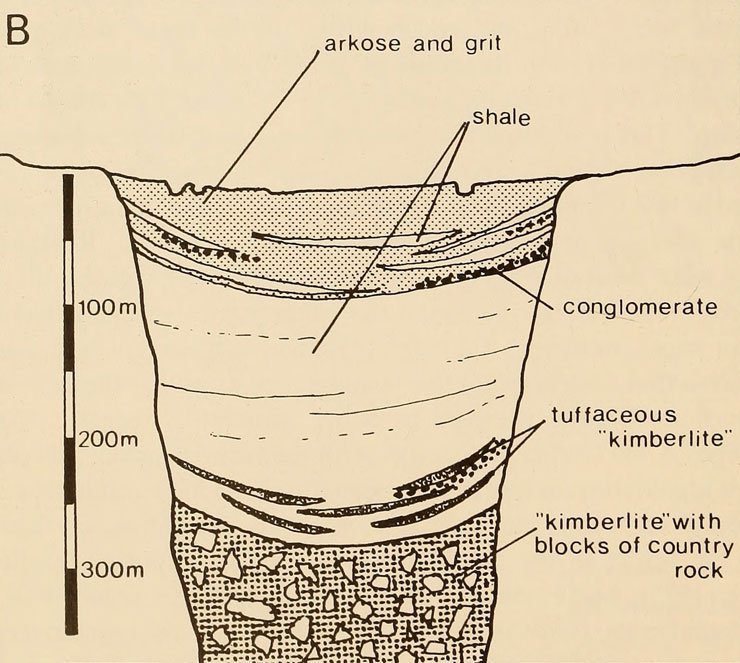
Winkler Crater is located near the town of Winkler in northern Riley County. It has long fascinated the locals, since it is perfectly round and 950 feet across. Its surface is covered by grass and trees and crossed by streams.
Throughout the 1960s, scientists speculated that the crater was caused by a falling meteorite. This theory was supported by magnetic anomalies in the crater.
Contents
Impact Crater or Kimberly Pipe?
Drilling in 1969 revealed a surprise, however—kimberlite fragments. The result was that geologists at K-State recommended that Winkler Crater be removed from the list of possible meteorite craters.
Kimberlite is an igneous rock, while most Kansas rocks are sedimentary. This greenish rock was named for Kimberly, South Africa, where it occurs in abundance. Weathered kimberlite, or “yellow ground” is soft and clayey. Deeper digging reveals harder “blue ground.” The temperature and pressure where kimberlite is formed can be intense, sometimes creating a situation ideal for crystallizing carbon into diamond.
A kimberly pipe occurs when carbon dioxide and water vapor shove molten rock up through the earth’s crust, ripping through other rock as it goes. Any diamonds present in the kimberlite are carried to the surface. When the kimberly pipe reaches the top of the ground, it explodes violently, forming a crater.
However, it is important to note that not all kimberly pipes contain diamonds. While there are thousands of known kimberly pipes across the world, less than a thousand contain any diamonds. Of the kimberly pipes that do contain diamonds, only a handful are commercially viable. Industrial-grade diamonds are not valuable enough to justify the cost of mining a kimberly pipe. Most diamond mines in the world today offer a yield of at least 20% gem-quality diamonds. Scientists currently have no explanation of why some kimberlites are valuable and others are not.
Kimberlites were not entirely new to Kansans. The first was found in the late 1800s, and more turned up in the 1930s and 1950s.
More Kimberlites Since 1969

The presence of Winkler Crater and other kimberlites in Kansas prompted a search for more of these unusual rocks, some of which have been buried in soil since their formation. In the 1980s, two methods were used to hunt for kimberly pipes:
- Aeromagnetic surveys.
- Panning streams for minerals, such as garnet, often found in association with kimberlite.
These two methods revealed the presence of four previously undiscovered pipes.
Because kimberly pipes often contain magnetic rocks, magnetic surveys were conducted in the 1990s, turning up the locations of three more pipes.
At present, 12 kimberlites have been found in Riley County and one in Marshall County.
Diamonds in Kansas?
For decades, Kansas geologists have cautioned that the chances of finding a valuable diamond mine in the state are slim to none, simply because so few kimberly pipes qualify as valuable.
The presence of small, low-quality diamonds is up for debate. Riley County kimberly pipes were probed in the 1980s when Cominco American, a mining company dating back to 1966, leased several of them, dug samples with backhoes, sifted the kimberlite, and took x-rays. The company reported finding two small diamonds, each about three millimeters in diameter.
However, a Kansas Geological Survey (KGS) publication from 2000 claims:
There is no record that diamonds have been found in Kansas, either in kimberlite rock, stream gravels, or glacial deposits.
The reason? KGS geologists suggest that the Riley County samples may have been inadvertently mixed up with kimberlite samples from other sources.
The kimberly pipes of Kansas are located on private land, so no prospectors are allowed to try their luck without permission. Some landowners enjoy a periodic search for precious stones, frequently turning up other interesting but less valuable finds like garnets. Whether anyone will ever find a sizeable diamond in Kansas remains in doubt.
Helpful Resources
Kansas Kimberlites
Information on the properties, history, and economic potential of kimberlites in Kansas from KGS. Follow the navigation links to read the entire article.
“Diamonds in Kansas? Maybe”
News release from 1996 addressing the Cominco diamond finds in Riley County.

